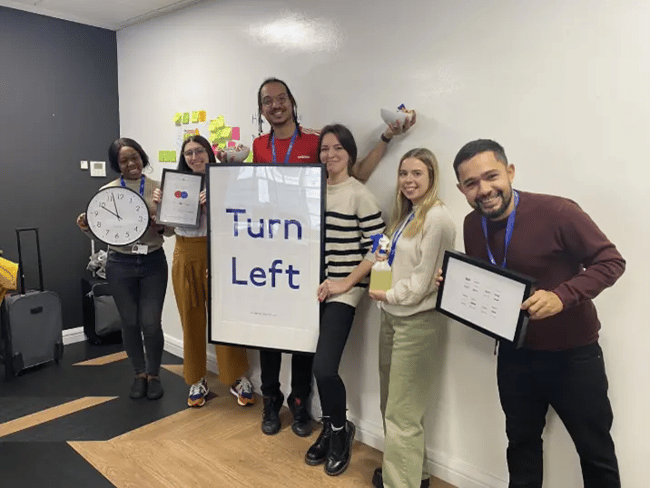It’s time to rethink design education in the UK because, at present, it’s broken.
My daughter is currently preparing for her SATs. When I asked her how it was going, she said, “Dad, we’ve been practicing since October.”
I have four children and my wife is a teacher. This gives me some insight into our education system.
It seems to me that it's focused on preparing students for an employment model from the past, rather than giving the skills they’ll need to thrive in a digital future.
The system emphasises learning to pass a test and the regurgitation of facts, rather than learning how to navigate ambiguity and deal with change.
It’s little wonder that a Ted Talk by Sir Ken Robinson titled ‘Do schools kill Creativity?’ has received over 22 million views on YouTube.
There’s no STEAMD in STEM
Statistics from the UK show that students studying design and technology GCSEs have fallen by 68% from 2010 to 2021.
Current entry rates to creative subjects at key stage 4 have fallen to the lowest in a decade.
This decline is in contrast with increases in some other GCSE subjects, notably those included in the English baccalaureate (EBacc) which is the suite of subjects on which the government judges school performance.
Rather surprisingly, to my mind, the current EBacc does not include any art or design subjects.
The importance of teaching research and design skills
Designers are fundamentally curious.
They seek to understand a current state; define a preferred future state; and uncover insights.
It’s a mindset that encourages people to...
- ask questions
- generate fresh ideas
- build
- test
- iterate
…so we can create things that deliver value, and have meaningful impact.
These are exactly the kind of qualities we need from the next generation.
That generation also happens to be faced with some of humanity's greatest challenges: our economy, our political systems, the health of the planet, and even the quality of our lives, all require new solutions and different ways of thinking.
That’s perhaps why research and design skills are in demand.
A recent report from the UK’s Design Council (PDF) shows that design contributed £97.4bn in gross value added (GVA) to the UK economy in 2019.
What might surprise you is that design isn’t limited to just product and service industries.
Around 77% of designers in the UK work in a wide range of non-design sectors such as architecture, engineering, fashion, psychology and sociology.
More than that, the skills designers use – collaboration, communication, critical thinking, creativity – are considered core 21st century skills and are those least likely to be replaced by A.I.
Bridging the gap between education and industry
One of our core values at SPARCK is about making time for others and being open to sharing knowledge and lived experience.
Following on from the success of the BJSS academy (SPARCK is part of BJSS) we’ve been able to run two SPARCK academies, on research and product design, and plan to run two more in 2023 and 2024.
The academy model provides graduates and career changers with the opportunity to gain their first professional role, and valuable commercial experience.

Above: SPARCK/BJSS design academy graduates in 2022.
In addition, since January 2023, we’ve been reaching out to universities near to our offices, offering to share our insights into human-centred design, and support to help nurture the next generation of researchers and designers.
1. Career guidance
For many, the path to that elusive first job in design isn’t clear.
Recently Kyle Browne from our Research team joined students from Warwick University to share his journey from PhD student to UX researcher, answer questions about how he did it, and share top tips.
2. Project feedback
Students from a wide range of disciplines can benefit from learning basic design skills and getting input on work while they’re doing it.
Azeem Butt, Mariana Gaspar Ferreira and Monica Costa were invited by Adam Galpin and students on the MSc media psychology design course at The University of Salford to give feedback on a project that involved the ethical use of personalisation technologies.
3. Guest lectures
For students, seeing real-work examples of how theory and practice come together in reality can help them reflect on their own ways of working.
We were invited by Professor Ed de Quincey from the School of Computer Science and Mathematics at Keele University to share a case study with students which gave an example of how human-centred Design and BJSS’s Enterprise Agile approach come together to deliver award winning projects.
4. Workshops
In collaboration with BJSS we’ve run workshops with local primary schools, scout groups and with students from local universities.
Inviting students into our office gives them a window into the world of work.
We’ve always aimed to share an insight into how multidisciplinary teams come together to explore problems, understand user needs and find creative solutions.
Antonio Labbate and Simon Penny recently ran a ‘Say hello to design thinking’ experiential workshop with second year engineering students from the University of Nottingham in our Nottingham office.
5. Sponsoring client led briefs
Client-led briefs gives students the opportunity to learn by working on real-life challenges.
Matt Mullan has been working with teams at the Centre for Innovation and Entrepreneurship, University of Bristol.
He’s been providing support for masters students to help them gain insights into design thinking, innovation and entrepreneurialism.
This collaboration is part of an essential module that challenges students to apply their innovation skills, which this year is focused on futures thinking.
6. Co-creating communities
Since January we’ve been co-hosting a meet-up called Service Designers Connect with Owen Beer at Nottingham Trent University.
Our mission is to create a platform for people in the East Midlands who are interested in service design to make connections, share best practice, and raise the profile of the profession.
How can you get involved?
As an industry, we can play a significant role in helping students acquire the skills and experience they’ll need to thrive in the digital future.
If you’re able, reach out to organisations in your local area and offer support, go for it, and feel free to use one of the formats suggested above.
As a society, the scale of what we need to design, and redesign, is immense.
By playing our part and helping increase awareness of the value design we can inspire the next generation of change makers.



